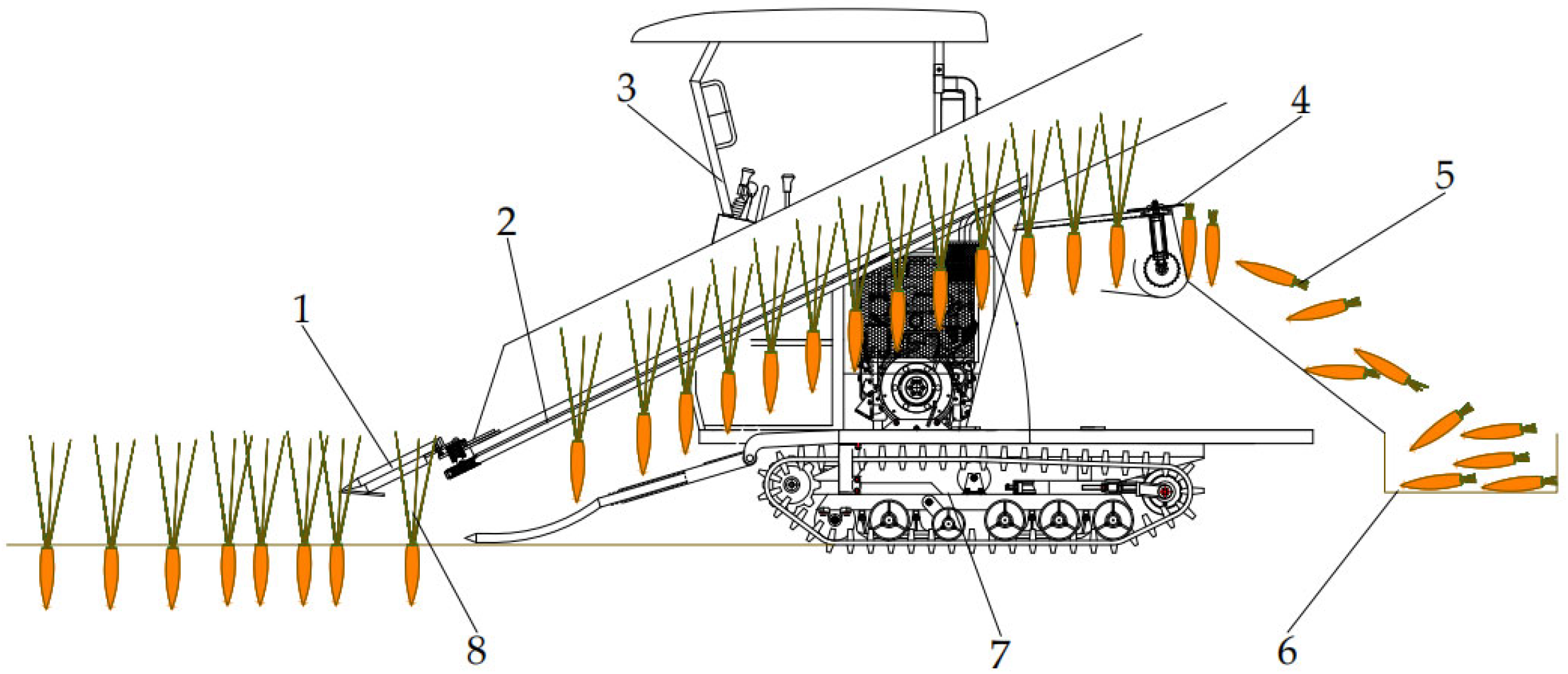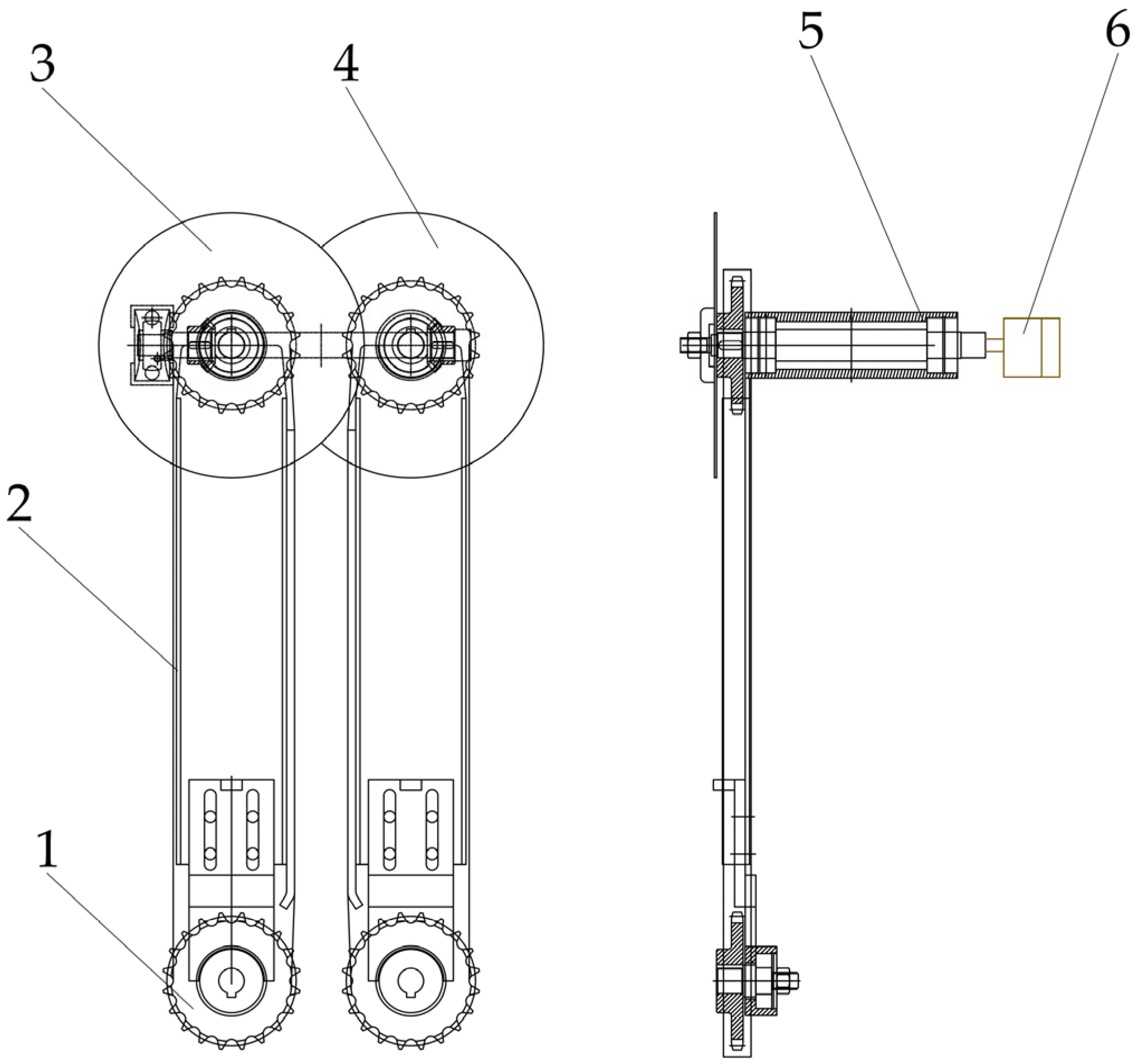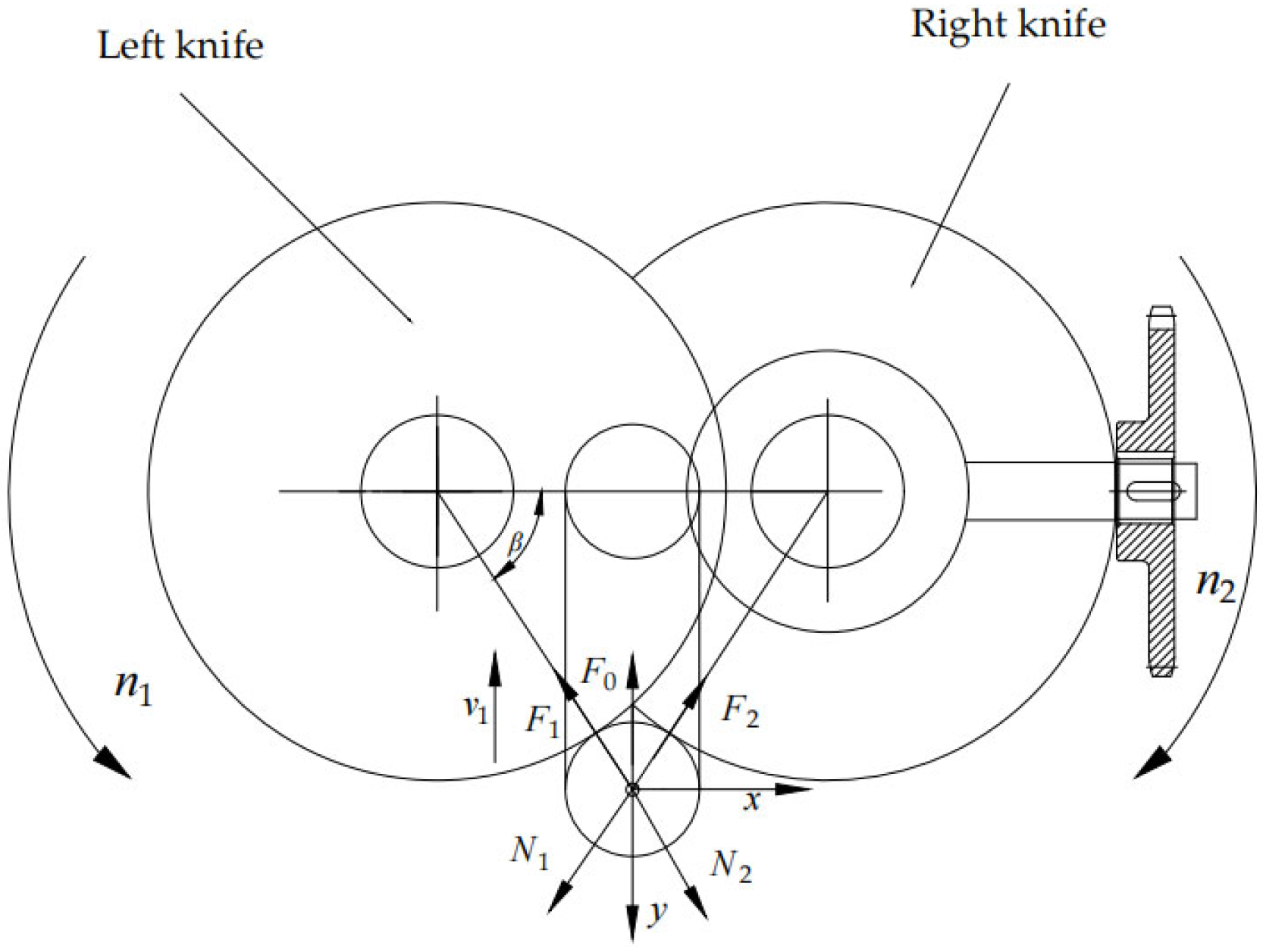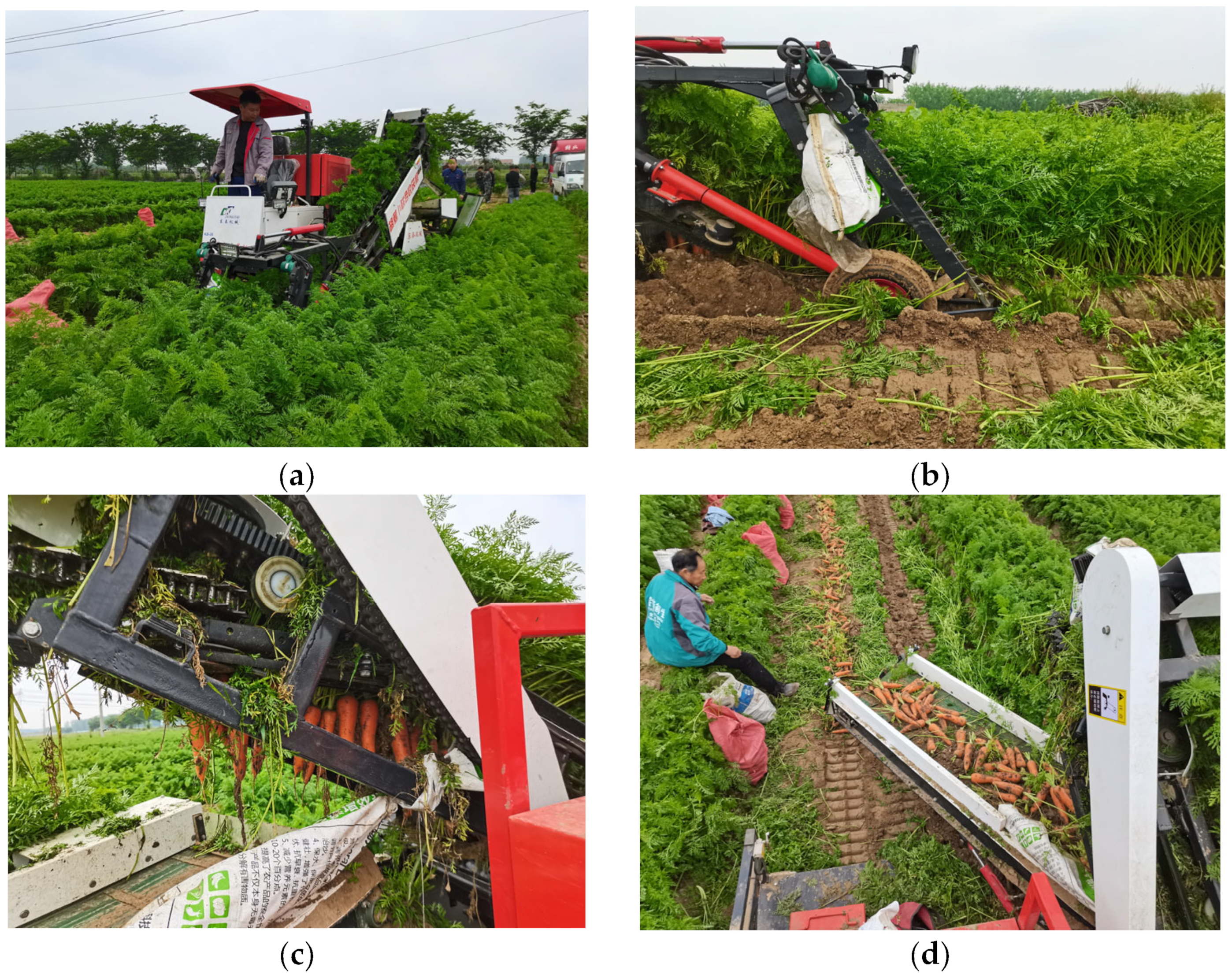Analysis and Evaluation of the Experimental Effect of Double-Disc Knife-Cutting Device for Carrot Combine Harvester
Abstract
:1. Introduction
2. Materials and Methods
2.1. Test Bench
2.2. Double-Disc Cutting Mechanism Design
2.2.1. Damage Rate Measurement Method
2.2.2. Motion Parameter Design
2.2.3. Disc Knife Structure Design
2.3. Test Condition
2.4. Evaluation Criteria and Calculation Method
2.5. Experimental Program Design
3. Results
3.1. Results and Analyses of Multifactorial Tests
- (1)
- Analysis of the effect of factors on the damage rate of carrot rootstock.
- (2)
- Analysis of the effect of various factors on stem and leaf cutting efficiency.
- (3)
- Analysis of the effect of factors on the cutting surface flatness rate.
3.2. Test Optimization and Validation
4. Discussion
5. Conclusions
Author Contributions
Funding
Institutional Review Board Statement
Informed Consent Statement
Data Availability Statement
Acknowledgments
Conflicts of Interest
References
- Xia, X.; Xu, Z.; Yu, C.; Zhou, Q.; Chen, J. Finite Element Analysis and Experiment of the Bruise Behavior of Carrot under Impact Loading. Agriculture 2021, 11, 471. [Google Scholar] [CrossRef]
- Zhang, Z.; Gan, S.; Zuo, G.; Tong, J. Bionic Design and Performance Experiment of Sandfish Head Inspired Subsoiler Tine. Trans. Chin. Soc. Agric. Mach. 2021, 52, 33–42. [Google Scholar]
- Gao, P.X. Research on On-Line Detection of Carrot Surface Defects Based on Deep Learning. Master’s Thesis, Northeast Agricultural University, Harbin, China, 2022. [Google Scholar]
- Yin, K. Study on Physical and Mechanical Properties of Carrot and Soil During Harvest. Master’s Thesis, Shandong Agricultural University, Tai’an, China, 2017. [Google Scholar]
- Inman, J.W. Fresh Vegetable Harvesting. ProQuest Agric. J. 2003, 10, 7–8. [Google Scholar]
- El Didamony, M.I.; El Shal, A.M. Fabrication and Evaluation of a Cabbage Harvester Prototype. Agriculture 2020, 10, 631. [Google Scholar] [CrossRef]
- Mathanker, S.K.; Grift, T.E.; Hansen, A.C. Effect of blade oblique angle and cutting speed on cutting energy for energy cane stems. Biosyst. Eng. 2015, 133, 64–70. [Google Scholar] [CrossRef]
- Xu, Z.H. Study on Impact Damage Mechanism of Carrot Root-Stem Pulling Separation and Development of Separation Device. Master’s Thesis, Zhejiang Sci-Tech University, Hangzhou, China, 2021. [Google Scholar]
- Jin, X.; Du, X.W.; Wang, S.G.; Ji, J.T.; Dong, X.; Wang, D.Y. Design and Experiment of Stems Cutting Device for Carrot Harvester. Trans. Chin. Soc. Agric. Mach. 2016, 3, 82–89, (In Chinese with English Abstract). [Google Scholar]
- Zeng, G.J.; Chen, J.N.; Xia, X.D.; Ye, J.; He, Y.N. Experimental study on pull type carrotroot-stem separation based on response surface method. J. Chin. Agric. Mech. 2023, 44, 1–8, (In Chinese with English Abstract). [Google Scholar]
- Zhao, Z.H.; Wang, J.S.; Yang, L.L.; Shao, Z.T. Optimal Design of Carrot Digging Shovel Based on Discrete Element Method. J. Agric. Mech. Res. 2024, 46, 139–145, (In Chinese with English Abstract). [Google Scholar]
- Liu, Q. Design and Research on Key Components of Excavating Radish Combine Harvester. Master’s Thesis, Shandong Agricultural University, Tai’an, China, 2019. [Google Scholar]
- Lu, G.Y.; Shang, S.Q.; Wang, D.W.; Li, J.D.; Han, W.P.; He, X.N. Study on Lacy Components of Carrot Harvester. J. Agric. Mech. Res. 2016, 38, 119–122+127. [Google Scholar]
- Guan, R. Design and Experiment of Bionic Single Disc to Top Cutting Device for Carrot Combine Harvester. Master’s Thesis, Northeast Agricultural University, Harbin, China, 2020. [Google Scholar]
- Jin, W.; Xiang, L.; Peng, G.; Ming, N.; Qi, W.; Wen, Z. Design and Experiment of High Efficiency Drag Reducing Shovel for Carrot Combine Harvester. Trans. Chin. Soc. Agric. Mach. 2020, 51, 93–103, (In Chinese with English Abstract). [Google Scholar]
- Li, K. Research on the Key Techniques of Self-Propelled Carrots Combine Harvester. Master’s Thesis, Chinese Academy of Agricultural Mechanization Sciences, Beijing, China, 2015. [Google Scholar]
- Kong, F.T.; Wang, D.F.; Shi, L.; Wu, T.; Chen, C.L.; Sun, Y.F.; Xie, Q. Design and experiment of disc-cutting picking device of castor. Trans. Chin. Soc. Agric. Eng. 2021, 37, 1–9, (In Chinese with English Abstract). [Google Scholar]
- Gong, Y.J.; Tong, L.L.; Qin, J.W. Design and experiment on carrot micro-comminution cutters. Trans. Chin. Soc. Agric. Eng. 2012, 28, 64–69, (In Chinese with English Abstract). [Google Scholar]
- Wang, B.; Hu, Z.; Wu, F.; Gu, F. Analysis and Evaluation of Harvest Quality Effectiveness of Carrot Clamping and Conveying Device. Agriculture 2025, 15, 275. [Google Scholar] [CrossRef]
- Rybacki, P.; Przygodziński, P.; Osuch, A.; Osuch, E.; Kowalik, I. Artificial Neural Network Model for Predicting Carrot Root Yield Loss in Relation to Mechanical Heading. Agriculture 2024, 14, 1755. [Google Scholar] [CrossRef]
- Kong, F.T.; Wu, T.; Zhang, B.; Zhao, H.Y.; Sun, Y.F.; Chen, C.L.; Xie, Q. Edge curve fitting and optimization of the wave-type cutting disc for castor. Trans. Chin. Soc. Agric. Eng 2024, 40, 66–75, (In Chinese with English Abstract). [Google Scholar]
- Zhao, G.L. Research on Small Self-Propelled White Radish Harvester. Master’s Thesis, Kunming University of Science and Technology, Kunming, China, 2023. [Google Scholar]
- Yao, S.; Xue, Z.; Miao, L.; Tan, J.; Huang, Y.C.; Zhao, Z. Design and experiment of pulling white radish combine harvester. J. Chin. Agric. Mech. 2023, 44, 27–33. [Google Scholar]










| Parameters | Values |
|---|---|
| Boundary dimension (length × width × height)/(mm × mm × mm) | 4450 × 2015 × 2540 mm |
| Rated power of engine/kW | 33.8 |
| Rated engine speed/(r × min−1) | 2400 |
| Working width/m | 2.2 |
| Efficiency/(hm2·h−1) | 0.19 |
| Results | Evaluation and Judgement Methods | Schematic Diagram |
|---|---|---|
| Pass | Pass Size | Figure 6a |
| Root and stem damage rate | Carrot stems and fruits are damaged if the epidermis is detached and the flesh tissue is broken | Figure 6b |
| Stem and leaf cutting rate | For the convenience of statistics, the length of carrot stem and leaves remaining after cutting is greater than 40 mm, which is regarded as unclean stem and leaves cutting | Figure 6c |
| Flatness of cut surface | Deducting the stem and leaf cuttings, the unevenness of the cutting surface is considered as uneven cutting | Figure 6d |
| Level | Factors | ||
|---|---|---|---|
| Clamping and Conveying Speed x1/(m/s) | Rotational Speed of Disc Cutter x2/(r/min) | Thickness of Disc Cutter x3/(mm) | |
| 1 | 0.65 | 150 | 2 |
| 2 | 1.05 | 180 | 4 |
| 3 | 1.45 | 210 | 6 |
| No. | Factors | ||
|---|---|---|---|
| Clamping and Conveying Speed x1/(m/s) | Rotational Speed of Disc Cutter x2/(r/min) | Thickness of Disc Cutter x3/(mm) | |
| 1 | 0 | 1 | −1 |
| 2 | 0 | 1 | 1 |
| 3 | 1 | 0 | −1 |
| 4 | −1 | 1 | 0 |
| 5 | 0 | −1 | 1 |
| 6 | −1 | 0 | 1 |
| 7 | 1 | 0 | 1 |
| 8 | 1 | 1 | 0 |
| 9 | 0 | 0 | 0 |
| 10 | 0 | 0 | 0 |
| 11 | 0 | −1 | −1 |
| 12 | 0 | 0 | 0 |
| 13 | −1 | 0 | −1 |
| 14 | 1 | −1 | 0 |
| 15 | −1 | −1 | 0 |
| 16 | 0 | 0 | 0 |
| 17 | 0 | 0 | 0 |
| No. | Clamping and Conveying Speed x1/(m/s) | Rotational Speed of Disc Cutter x2/(r/min) | Thickness of Disc Cutter x3/(mm) | Root and Stem Damage Rate Y1/% | Performance Indicators Stem and Leaf Cutting Rate Y2/% | Cutting Surface Flatness Rate Y3/% |
|---|---|---|---|---|---|---|
| 1 | 0 | 1 | −1 | 4.52 | 92.22 | 79.25 |
| 2 | 0 | 1 | 1 | 5.13 | 87.13 | 69.70 |
| 3 | 1 | 0 | −1 | 4.21 | 84.11 | 76.14 |
| 4 | −1 | 1 | 0 | 3.72 | 95.27 | 81.23 |
| 5 | 0 | −1 | 1 | 4.76 | 78.98 | 72.30 |
| 6 | −1 | 0 | 1 | 4.56 | 76.33 | 73.30 |
| 7 | 1 | 0 | 1 | 4.83 | 70.65 | 66.64 |
| 8 | 1 | 1 | 0 | 4.03 | 89.94 | 75.20 |
| 9 | 0 | 0 | 0 | 2.51 | 88.34 | 90.19 |
| 10 | 0 | 0 | 0 | 2.62 | 89.13 | 91.39 |
| 11 | 0 | −1 | −1 | 4.12 | 80.67 | 82.11 |
| 12 | 0 | 0 | 0 | 2.56 | 88.98 | 90.82 |
| 13 | −1 | 0 | −1 | 3.91 | 81.32 | 83.12 |
| 14 | 1 | −1 | 0 | 3.62 | 76.25 | 78.62 |
| 15 | −1 | −1 | 0 | 3.36 | 83.88 | 85.54 |
| 16 | 0 | 0 | 0 | 2.63 | 88.96 | 92.69 |
| 17 | 0 | 0 | 0 | 2.57 | 87.25 | 91.83 |
| Source | Root and Stem Damage Rate Y1 | |||
|---|---|---|---|---|
| Sum of Squares | Degrees of Freedom | F | p | |
| Model | 12.83 | 9 | 1047.08 | <0.0001 |
| x1x1 | 0.1625 | 1 | 119.32 | <0.0001 |
| x2x2 | 0.2965 | 1 | 217.75 | <0.0001 |
| x3x3 | 0.7938 | 1 | 583.06 | <0.0001 |
| x1x2 | 0.0006 | 1 | 0.4591 | 0.5198 |
| x1x3 | 0.0002 | 1 | 0.1653 | 0.6965 |
| x2x3 | 0.0002 | 1 | 0.1653 | 0.6965 |
| x12 | 0.7596 | 1 | 557.97 | <0.0001 |
| x22 | 1.95 | 1 | 1429.03 | <0.0001 |
| x32 | 7.96 | 1 | 5845.06 | <0.0001 |
| Residual | 0.0095 | 7 | ||
| Mismatch | 0.0001 | 3 | 0.0070 | 0.9991 |
| Error checking | 0.0095 | 4 | ||
| Sum | 12.84 | 16 | ||
| Source | Stem and Leaf Clearance Y2 | |||
|---|---|---|---|---|
| Sum of Squares | Degrees of Freedom | F | p | |
| Model | 597.04 | 9 | 12.99 | 0.0014 |
| x1x1 | 31.40 | 1 | 6.15 | 0.0422 |
| x2x2 | 46.18 | 1 | 9.04 | 0.0197 |
| x3x3 | 79.57 | 1 | 15.58 | 0.0055 |
| x1x2 | 1.32 | 1 | 0.2590 | 0.6264 |
| x1x3 | 17.94 | 1 | 3.51 | 0.1030 |
| x2x3 | 2.89 | 1 | 0.5660 | 0.4764 |
| x12 | 82.34 | 1 | 16.13 | 0.0051 |
| x22 | 140.41 | 1 | 27.50 | 0.0012 |
| x32 | 151.95 | 1 | 29.76 | 0.0010 |
| Residual | 35.74 | 7 | ||
| Mismatch | 33.32 | 3 | 18.34 | 0.0084 |
| Error checking | 2.42 | 4 | ||
| Sum | 632.78 | 16 | ||
| Source | Cutting Surface Flatness Rate Y3 | |||
|---|---|---|---|---|
| Sum of Squares | Degrees of Freedom | F | p | |
| Model | 88.38 | 9 | 196.43 | <0.0001 |
| x1x1 | 21.75 | 1 | 142.15 | <0.0001 |
| x2x2 | 187.02 | 1 | 34.98 | 0.0006 |
| x3x3 | 0.1980 | 1 | 300.80 | <0.0001 |
| x1x2 | 0.0256 | 1 | 0.3185 | 0.5901 |
| x1x3 | 0.0169 | 1 | 0.0412 | 0.8450 |
| x2x3 | 158.64 | 1 | 0.0272 | 0.8737 |
| x12 | 109.44 | 1 | 255.16 | <0.0001 |
| x22 | 459.43 | 1 | 176.02 | <0.0001 |
| x32 | 88.38 | 1 | 738.94 | <0.0001 |
| Residual | 4.35 | 7 | ||
| Mismatch | 0.7038 | 3 | 0.2572 | 0.8532 |
| Error checking | 3.65 | 4 | ||
| Sum | 1103.49 | 16 | ||
Disclaimer/Publisher’s Note: The statements, opinions and data contained in all publications are solely those of the individual author(s) and contributor(s) and not of MDPI and/or the editor(s). MDPI and/or the editor(s) disclaim responsibility for any injury to people or property resulting from any ideas, methods, instructions or products referred to in the content. |
© 2025 by the authors. Licensee MDPI, Basel, Switzerland. This article is an open access article distributed under the terms and conditions of the Creative Commons Attribution (CC BY) license (https://creativecommons.org/licenses/by/4.0/).
Share and Cite
Wang, B.; Hu, Z.; Gu, F.; Wu, F.; Cao, M.; Sun, Y. Analysis and Evaluation of the Experimental Effect of Double-Disc Knife-Cutting Device for Carrot Combine Harvester. Agriculture 2025, 15, 682. https://doi.org/10.3390/agriculture15070682
Wang B, Hu Z, Gu F, Wu F, Cao M, Sun Y. Analysis and Evaluation of the Experimental Effect of Double-Disc Knife-Cutting Device for Carrot Combine Harvester. Agriculture. 2025; 15(7):682. https://doi.org/10.3390/agriculture15070682
Chicago/Turabian StyleWang, Bokai, Zhichao Hu, Fengwei Gu, Feng Wu, Mingzhu Cao, and Yunjing Sun. 2025. "Analysis and Evaluation of the Experimental Effect of Double-Disc Knife-Cutting Device for Carrot Combine Harvester" Agriculture 15, no. 7: 682. https://doi.org/10.3390/agriculture15070682
APA StyleWang, B., Hu, Z., Gu, F., Wu, F., Cao, M., & Sun, Y. (2025). Analysis and Evaluation of the Experimental Effect of Double-Disc Knife-Cutting Device for Carrot Combine Harvester. Agriculture, 15(7), 682. https://doi.org/10.3390/agriculture15070682







